Magnetization and magnetic materials
The presence of a substance with magnetic properties is manifested in a change in the parameters of the magnetic field compared to the field in non-magnetic space. The occurring physical processes in the microscopic representation are associated with the appearance in the material under the influence of a magnetic field of magnetic moments of microcurrents, the volume density of which is called the magnetization vector.
The appearance of magnetization in the substance when you place it inside magnetic field is explained by the process of gradual preferential orientation magnetic moments circulating in it microcurrents in the direction of the field. A huge contribution to the creation of microcurrents in the substance is the movement of electrons: rotation and orbital movement of electrons associated with atoms, spin and free movement of conduction electrons.
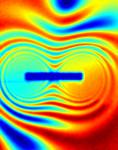 According to their magnetic properties, all materials are divided into paramagnets, diamagnets, ferromagnets, antiferromagnets and ferrites... The belonging of a material to one or another class is determined by the nature of the reaction of the magnetic moments of electrons to a magnetic field under conditions of strong interactions of electrons with each other in multielectron atoms and crystal structures.
According to their magnetic properties, all materials are divided into paramagnets, diamagnets, ferromagnets, antiferromagnets and ferrites... The belonging of a material to one or another class is determined by the nature of the reaction of the magnetic moments of electrons to a magnetic field under conditions of strong interactions of electrons with each other in multielectron atoms and crystal structures.
Diamagnets and paramagnets are weakly magnetic materials. A much stronger magnetization effect is observed in ferromagnets.
Magnetic susceptibility (the ratio of the absolute values of the magnetization and field strength vectors) for such materials is positive and can reach several tens of thousands. In ferromagnets, regions of spontaneous unidirectional magnetization — domains — are formed.
Ferromagnetism observed in crystals of transition metals: iron, cobalt, nickel and a number of alloys.
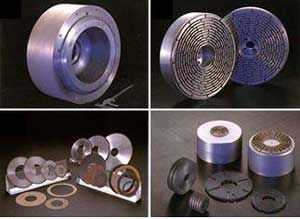
When an external magnetic field of increasing strength is applied, the spontaneous magnetization vectors, initially oriented in different areas in different ways, gradually align in the same direction. This process is called technical magnetization… It is characterized by an initial magnetization curve—the dependence of the induction or magnetization on the resulting magnetic field strength in the material.
With a relatively small field strength (Section I) there is a rapid increase in magnetization, mainly due to an increase in the size of the domains with the magnetization orientation in the positive hemisphere of the directions of the field strength vectors. At the same time, the sizes of the domains in the negative hemisphere are reduced proportionally.To a lesser extent, the dimensions of these regions change, the magnetization of which is oriented closer to the plane orthogonal to the intensity vector.
With a further increase in intensity, the processes of rotation of the domain magnetization vectors along the field predominate (section II) until technical saturation is reached (point S). The subsequent increase of the resulting magnetization and the achievement of the same orientation of all regions in the field is hindered by the thermal motion of the electrons. Region III is similar in nature to paramagnetic processes, where the increase in magnetization is due to the orientation of the few spin magnetic moments disoriented by thermal motion. With increasing temperature, the disorienting thermal motion increases and the magnetization of the substance decreases.
For a given ferromagnetic material, there is a certain temperature at which the ferromagnetic ordering of the domain structure and the magnetization disappear. The material becomes paramagnetic. This temperature is called the Curie point. For iron, the Curie point corresponds to 790 ° C, for nickel - 340 ° C, for cobalt - 1150 ° C.
Decreasing the temperature below the Curie point restores the magnetic properties of the material again: the domain structure with zero network magnetization if there is no external magnetic field. Therefore, heating products made of ferromagnetic materials above the Curie point are used to completely demagnetize them.
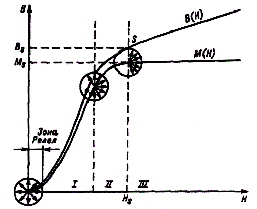
Initial magnetization curve
Processes of magnetization of ferromagnetic materials divided into reversible and irreversible in connection with the change in the magnetic field.If, after removing the external field disturbances, the magnetization of the material returns to its original state, then this process is reversible, otherwise it is irreversible.
Reversible changes are observed in a small initial segment of section I magnetization curve (Rayleigh zone) at small displacements of the domain walls and in regions II, III when the magnetization vectors in the regions rotate. The main part of Section I deals with an irreversible process of magnetization reversal, which mainly determines the hysteresis properties of ferromagnetic materials (lag of changes in magnetization from changes in the magnetic field).
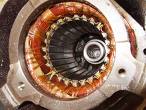 Hysteresis loop called curves reflecting the change in the magnetization of a ferromagnet under the influence of a cyclically changing external magnetic field.
Hysteresis loop called curves reflecting the change in the magnetization of a ferromagnet under the influence of a cyclically changing external magnetic field.
When testing magnetic materials, hysteresis loops are constructed for the functions of the magnetic field parameters B (H) or M (H), which have the meaning of the obtained parameters inside the material in a projection on a fixed direction. If the material was previously completely demagnetized, then a gradual increase in the magnetic field strength from zero to Hs gives many points from the initial magnetization curve (Section 0-1).
Point 1 — technical saturation point (Bs, Hs). The subsequent reduction of the force H inside the material to zero (Section 1-2) makes it possible to determine the limit (maximum) value of the residual magnetization Br and further reduce the negative field strength to achieve complete demagnetization B = 0 ( section 2-3) at the point H = -HcV - the maximum coercive force during magnetization.
Furthermore, the material is magnetized in the negative direction to saturation (Section 3-4) at H = — Hs. A change in field strength in a positive direction closes the limiting hysteresis loop along the 4-5-6-1 curve.
Many material states within the hysteresis limit cycle can be achieved by changing the magnetic field strength corresponding partial symmetric and asymmetric hysteresis cycles.
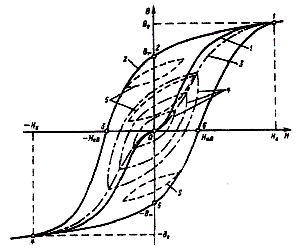
Magnetic hysteresis: 1 — initial magnetization curve; 2 — hysteresis limit cycle; 3 — curve of the main magnetization; 4 — symmetric partial cycles; 5 — asymmetric partial loops
Partially symmetric hysteresis cycles rest their vertices on the main magnetization curve, which is defined as the set of vertices of these cycles until they coincide with the limit cycle.
Partial asymmetric hysteresis loops are formed if the starting point is not on the main magnetization curve with a symmetric change in field strength, as well as with an asymmetric change in field strength in the positive or negative direction.
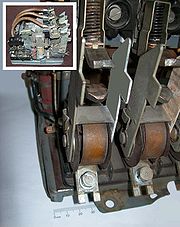 Depending on the values of the coercive force, ferromagnetic materials are divided into magnetically soft and magnetically hard.
Depending on the values of the coercive force, ferromagnetic materials are divided into magnetically soft and magnetically hard.
Soft magnetic materials are used in magnetic systems as magnetic cores... These materials have low coercive force, high magnetic permeability and saturation induction.
Hard magnetic materials have a large coercive force and in the pre-magnetized state are used as permanent magnets — primary sources of magnetic field.
There are materials to which, according to their magnetic properties, antiferromagnets belong... The antiparallel arrangement of the spins of neighboring atoms turns out to be energetically more favorable for them. Antiferromagnets have been created that have a significant intrinsic magnetic moment due to crystal lattice asymmetry... Such materials are called ferrimagnets (ferrites)... Unlike metallic ferromagnetic materials, ferrites are semiconductors and have significantly lower energy losses for eddy currents in alternating magnetic fields.
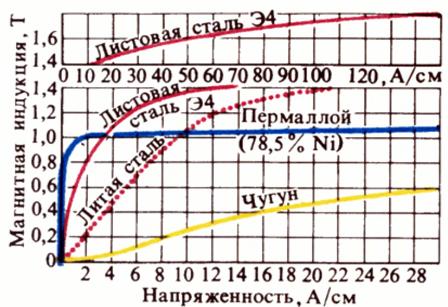
Magnetization curves of various ferromagnetic materials
